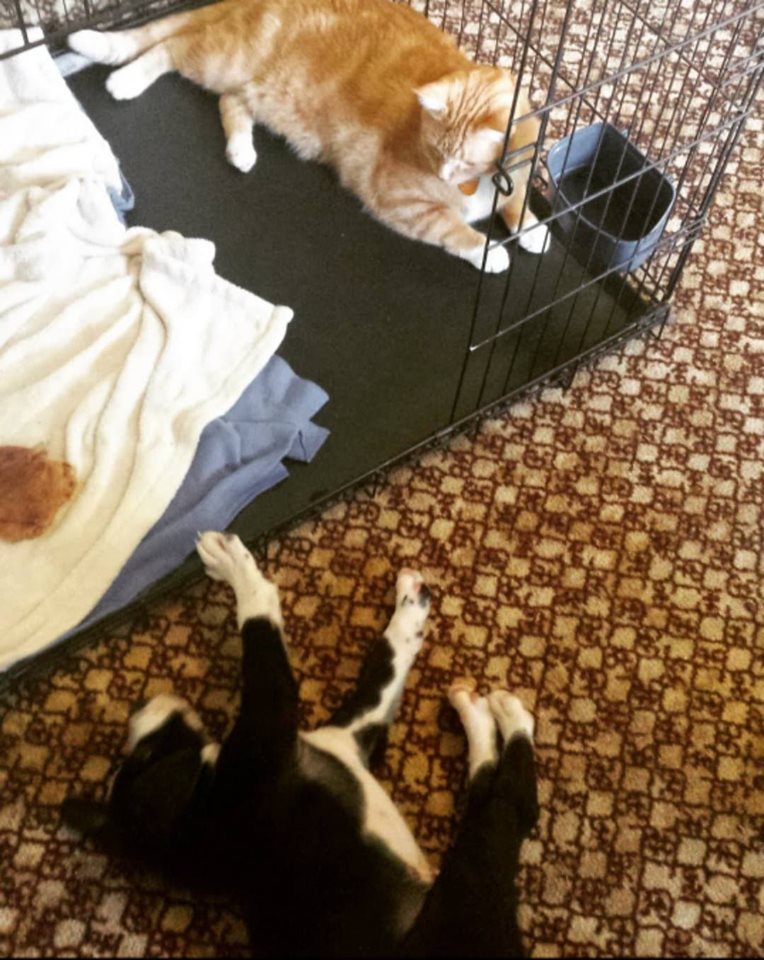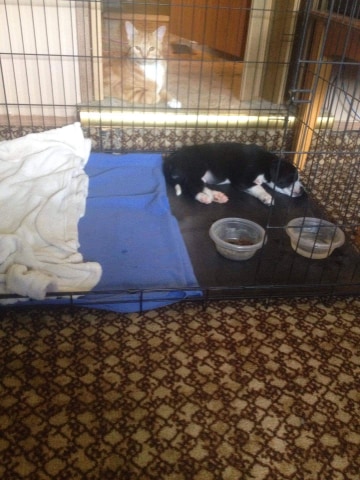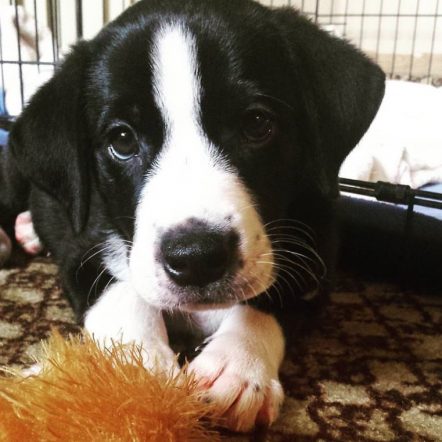Ever wondered how crate training works? I have and I also wondered if it was cruel or necessary. It is not cruel in any way if you’re doing it right. Some dogs however have that natural instinct to be more comfortable in a “den” situation. There are some rules I suggest following if you choose to crate train your pup. Some dogs are more comfortable in a crate than in an open space. I don’t suggest using the crate to correct common behavioral problems in most dogs. Use the crate as a safe haven, not a punishment.
Table of Contents
Never use a crate for these reasons
- You should never use the crate as punishment. EVER! They will become fearful of going into the crate.
- Never leave them in the crate while you spend the whole day at work. Although it can be convenient in making sure your puppy doesn’t chew on things or get hurt while you’re at work. But you need to hire someone that will come in and let your dog out to go eliminate, or if they need food or companionship. Doggy Daycare really does eliminate this problem. It is also great for socialization.
- Puppies under 6 months old should never stay in the crate longer than three hours at a time at MOST. They are unable to hold their bladder or bowels for more than this time. Unlike older dogs.
- Crate train only during that crucial time of puppyhood. They may chew on stuff that can make them choke or cause an obstruction. It may be used for their safety.
- Once they are through the destructive stage and have more training there is no need to keep them locked away. Especially for your convenience. After this stage, they should be using their crate on their own. Meaning the crate should be a place they go voluntarily.
- If your dog is whining in the crate- NEVER yell at them or pound on the crate! Comfort them and try again. Having a puppy can be no different than getting up with your baby every few hours. It takes work. Don’t be a slacker!! Invest in your dog’s future by putting in the work. You made the commitment so you need to follow through. Just as you would when you commit to raising a child.
- Never crate them in a separate room. They need to be where your family spends the most time. Never isolate them in the crate away from you or your family.
Purpose of the crate
Crate training can help with protecting puppies during the destructive stage of discovering new things. As for issues like separation anxiety, I do recommend having a professional trainer teach you the basics before trying to crate train. Separation anxiety problems can only be resolved with desensitization and other training methods. You may want to consult a professional animal-behavior specialist for help.
Remember you would not want to spend your life in a cage. Dogs are animals that love to be with their people. Using the crate as a den for them to feel safe and secure. Never use your crate for your convenience, only for their safety and providing them security.
Introducing Your Pup To Other Pets
It can also be used to introduce a cat and a puppy. Providing a safe environment for both of the pets to adjust to one another. For example, the picture below shows the two switching places on their own to better know one another. This was my son’s and his wife’s puppy Jynx getting to know the queen of the house. They both worked around one another to properly train their puppy. But they also were able to provide a safe environment for him while they needed to work or go out. You will also see that left the door open when they were home.

Why Some Dogs Do NOT like Crate Training
This is especially true with a newly adopted puppy or older dog. They may not have had previous crate training or it was done the wrong way. Thus causing your dog to fear to go in the crate. Do not make them. Let them have choices. By doing this it will help build your pup’s confidence that they can make the right choices on their own.
Some dogs do not like confined spaces. You will need to train your pup to use the crate as a den or a safe place. Make it a good experience. Not a bad one. If your dog does not like the crate, NEVER force them to use it. Always make sure they go into the crate willingly.
Choosing the Right Crate
I highly recommend using Pinnacle Woodcraft. Amish Craftsmanship custom-built Wooden Dog Crates. They build Luxurious Quality Pet Canine Furniture. Founded by Jonas Zook Jr. Their crates will not harm the dog with any sharp edges if they chew on the pan. They are also handcrafted and made beautifully to fit nicely into the surroundings. Giving your dog more of that “den” feeling.
You can use the metal crates that fold up if your traveling. However, for your home, I suggest you take a look at the selection they have to offer.
How to Crate Train Your Dog Properly
You need to have some patience when crate training. It can take up to weeks to fully train your pup. So you may have to get up every few hours to let your pup outside or get them a drink of water.
Keep the crate clean and free from anything that may harm them. Never go too fast. If you have one bad experience, it will set you back and YOU WILL have to start over each time. So remember no yelling or punishments. Just a lot of patience and love.
Step One – Introduction to your Dog’s Crate
Dogs will associate positive things with the crate if you follow these steps. Place the crate in the rooms you spend the most time in. Start with the door open or off the crate if you can. Allowing your dog the sense of freedom to make the choice to enter on his own. Never just put them in. Let them go in on their own.

Let them check out the crate and be comfortable with the crate. Some dogs may just climb right in and start sleeping in the crate right away. Some dogs need a bit of help and if your dog is one of them. You can follow these steps to see if your dog will adjust to the crate in time.
Step Two – Adjustment
Start by making it fun. Use your puppy voice or a happy tone. Use a toy or treat and toss it near the crate than into the crate. (Remember to have the door open and secured so it doesn’t close or frightens them) Praise them with a higher quality treat once they go in to retrieve what you have tossed in. Using things that make a dog happy will help your dog associate the crate as being something positive, not negative.
Feeding them in the crate is not recommended unless absolutely needed to help them overcome their fears. When wild dogs use dens they do not eat or eliminate in their dens. However, I do suggest feeding them near the crate in the beginning. This way they can associate the crate with something rewarding and good. You want to be home when you do this.
Keep in mind you may have to feed them in the crate temporarily to help them adjust. Only do this until your dog is not showing any fear or anxiety when the door is closed as explained in step four.
Step Three – Closing the crate door
Once your dog is comfortable going into the crate, practice closing the door for ONLY SHORT INTERVALS OF TIME. If they start to whine you may have increased the time the door is shut too long too quickly. I suggest starting with 5 minutes and working your way up to 15 minutes.
If they start to whine or cry
Here is where it may get a bit complicated. Your dog may start to whine regularly, so you need to train them that once they stop whining, you will open the door. ONLY after they have worked up to a longer amount of time in the crate. After an hour they may need out to go to the bathroom or get a drink of water. YOU need to teach your dog how to communicate with you. Your dog depends on YOU to show them these things. This can take anywhere from days to weeks.
Step Four – Start Practicing Longer Crate Times
Clicker training is also a great option when training. Either way, once your dog is comfortable with going into the crate reward them. Start using command words such as “den” or “kennel”. Practice over and over only closing the door for small amounts of time like 10 minutes. Stay close to the crate. Reward them when they do not whine or paw to open the door.
Once they have shown they are comfortable, you can then start leaving the room for small amounts of time. I suggest starting with 5 -10 minutes. Come back into the room and let them out of the kennel. Praise them with a higher quality treat or favorite toy. Show them how proud of them you are. They will respond by wanting to please you more and more.
Practice is Important
You may need to repeat these steps over days to weeks. It depends on the age of the puppy and each one is different. You want to make sure your puppy does not get anxious or scared when the door is closed.
Once your dog stays quietly in the crate 30 minutes with you mostly out of sight, you can then begin leaving them crated when you’re gone for short time periods Or allowing them to sleep in the crate overnight. This may take several days or weeks. Remember if they start whining, you have increased the time in the cage too quickly.
Step Five – Getting Ready To Leave Routine
Only after your pup is comfortable and not feeling anxious or afraid in the crate should you be leaving them alone. You can then start to build your routine before and after you come home. Here is a review of what I recommended:
- Toss a favorite toy or treats into the crate. Practice leaving the door open when you have time at home. Try leaving their favorite toys in there in case of boredom. That is why I recommended using the pans made from Pinnacle Woodcraft. They will not harm your dog if they should start to chew on the pan. Signs of chewing are usually boredom or frustration. Your dog is trying to tell you something when this happens.
- Try getting them into the crate about 10 minutes before leaving. I don’t recommend leaving them in there longer than 20 minutes before leaving. At this point, they should still not be left alone in their crates longer than they are comfortable.
- Do not make your departure emotional, nor when you return. You want the dog to feel like it’s routine for comfort. Or even a command. Most dogs love to please their human by following commands as their job or place in their family. They should not whine or be uncomfortable in any way before you leave. That is why I recommend creating a short time before you leave.
- When you return home, you should not make it exciting and overwhelming for your pup. Relaxing and quiet entrance is always recommended to prevent any separation anxiety or excitement in anticipation of waiting for your return home each time.
- Use the crate while you’re at home, you do not want the dog to associate the crate with being alone. Dogs don’t like being alone. They love being with their people.
Crating Your Pup During the Night
When crating your dog at night make sure that the crate is nearby. Especially if they are puppies and will need to go outside for a bathroom break during the night. Usually every 2-3 hours under 6 months old. Older dogs should be close as well. Dogs don’t want to feel socially isolated.
Once the pup is comfortable sleeping in the crate at night. You can gradually move it to a location of your choice. Remember your dog will bond with you when they sleep close to you. It is time spent with you that matters to them the most.
Prevent Whining At Night
I can suggest at this point if your pup starts to whine regularly, they can be testing you. Let them out but do not play on the way to the door. You want this to be a necessity not play time. Make sure they are comfortable and if they continue to whine, you may have to let them whine a bit like you do a baby sometimes when settling in for the night. Give them 5 – 10 minutes before responding.
One reason your pup may be whining as mentioned before. Is that you have gone through the training too quickly. They do not have the confidence or understanding that the crate is OK. So each time you may have a small set back. But be vigilant and work on these things daily. It is very important to do this to prevent behavioral issues in the future.
Final Thoughts
I can honestly say being a skeptic myself at one time about crate training. I am confident that this is in no way cruel to your pup. Unless you’re doing it wrong of course! That is on you and not your pup. You need to figure out the best way to build your pup’s confidence in you and them.
It requires patience and time. Never punish your pet for not going into the crate and follow what I recommend above. If all else fails you need to call in a professional to evaluate the issues to prevent damage later on.
I have never used a crate because I was fearful that they would feel isolated. But I now have a better understanding of how important this can be in the early stages. My son is with a lovely girl that has background experience working in vet offices. Watching them do crate training amazed me and got my interest in the topic. I am hoping from my learning experience this can be a great educational tool on deciding if crate training may be the solution your looking for.
Especially seeing a pup raised with a crate and without. They both developed into healthy pets. Because I was home full time I was able to spend more time with my pup. But not everyone can do that. So this is a great way to teach your dog confidence and have a cozy place of their own to adjust to other animals and the new environment. Jynx has no issues and is a very well mannered pup. He even still sleeps where his crate use to be. That is his comfy spot now.








